Carnoustie Golf Links is one of the strongest links course designs in Scotland. A round at Carnoustie tests every aspect of a golfer’s game, and any lapse in concentration destroys the scorecard. The course is most commonly known for Jean van de Velde’s self destruction during the 1999 Open Championship and the extremely difficult course setup that same year, which led to a +6 winning score. As time passes and Carnoustie becomes distanced from those events, hopefully the course will become less known for its penal past, and better known for its great design. 
As you will see in the photos below, Carnoustie is not visually stunning, especially on a grey March day. The course has little “wow” factor, but is absolutely deserving of its ranking at #23 in the world. Golfers know that they have played something special after walking off the 18th green. To quote a friend of mine who has played the world’s best golf courses, “If every golf course has a personality, Carnoustie is that of a working man. Looking over Carnoustie from the first tee and you are bound to be disappointed. Be patient, however, and you will be rewarded.”
The course was originally laid out as a 10-hole track by the St Andrean Allan Robertson in 1840. Robertson was Old Tom Morris’s employer and mentor, and it was Old Tom who extended the course to 18 holes in 1867. In 1926, Braid added final routing touches that have lasted through to the current design. When looking at the photos in this post, it is worth keeping in mind that the rough has been cut down for the winter. Very high rough borders the fairways and greens during the summer months.
Hole #1 – 389 yards – “Cup”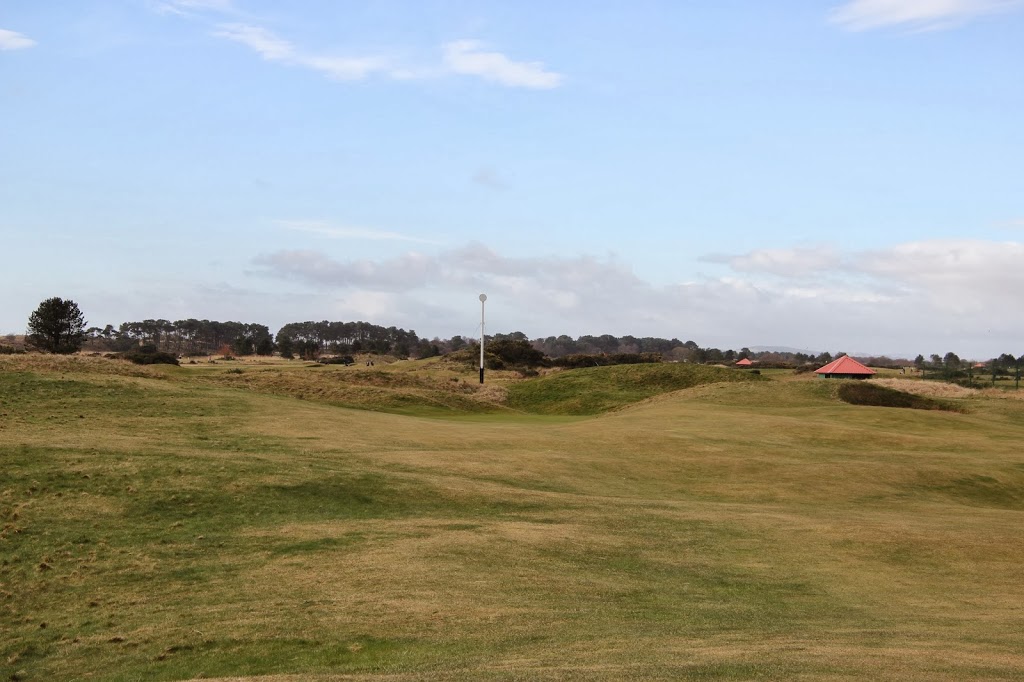 The course opens with a straight par 4. A sunken green creates a blind approach that is guided by a large white target pole. Bunkers down the right side of the fairway are a gentle introduction to the penal bunkering found later in the round.
The course opens with a straight par 4. A sunken green creates a blind approach that is guided by a large white target pole. Bunkers down the right side of the fairway are a gentle introduction to the penal bunkering found later in the round.
Hole #2 – 407 yards – “Gulley”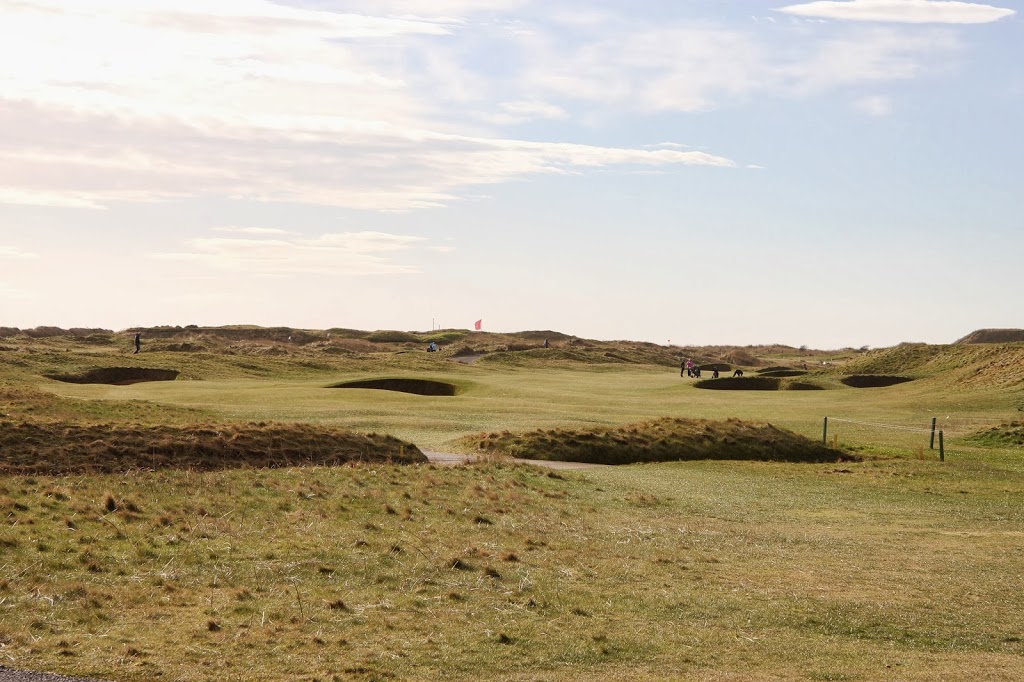 The view from the 2nd tee, as seen above, is intimidating with a seemingly bunker filled fairway ahead. The hole has a total of ten bunkers, and staying out the them is paramount to a good score.
The view from the 2nd tee, as seen above, is intimidating with a seemingly bunker filled fairway ahead. The hole has a total of ten bunkers, and staying out the them is paramount to a good score. The green, pictured above, is over fifty yards in length. Two bunkers guard the front left and right positions, while a single bunker on the left sits midway up the length of the green. Elongated greens with bunkers placed mid-putting surface are seen again later in the round.
The green, pictured above, is over fifty yards in length. Two bunkers guard the front left and right positions, while a single bunker on the left sits midway up the length of the green. Elongated greens with bunkers placed mid-putting surface are seen again later in the round.
Hole #3 – 331 yards – “Jockie’s Burn” Heavy rains and cold temperatures this winter caused a winter green to be in play on the 3rd hole during my round; therefore, ignore the white pin seen to the left of the green. The 3rd is a short hole that requires creativity and thought in order to be successful. Golfers must carefully choose a landing area, factoring in three deep bunkers and a meandering burn in front of the green.
Heavy rains and cold temperatures this winter caused a winter green to be in play on the 3rd hole during my round; therefore, ignore the white pin seen to the left of the green. The 3rd is a short hole that requires creativity and thought in order to be successful. Golfers must carefully choose a landing area, factoring in three deep bunkers and a meandering burn in front of the green. Jockie’s Burn is just short the 3rd green and is one of many to be seen later in the round. When the greens are fast and the turf is firm, this meandering stream is particularly dangerous.
Jockie’s Burn is just short the 3rd green and is one of many to be seen later in the round. When the greens are fast and the turf is firm, this meandering stream is particularly dangerous.
Hole #6 – 500 yards – “Hogan’s Alley”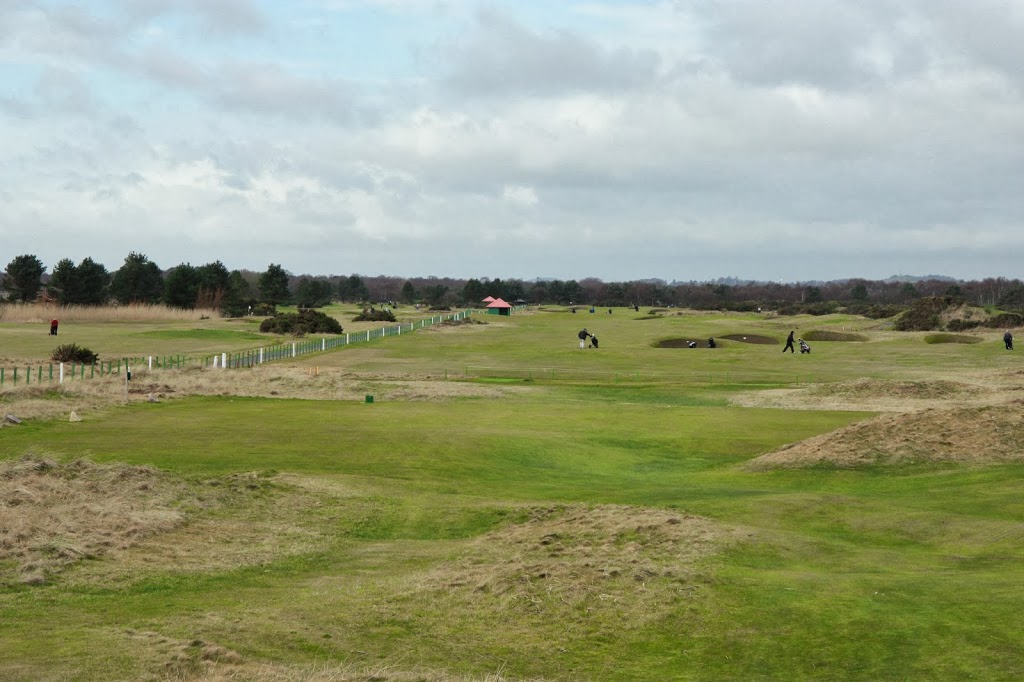 The 6th hole is one of only two par 5s at Carnoustie. A well placed drive is crucial on this hole in order to place a second shot close to the green. Out-of-bounds is much closer on the left side of the hole than it appears in this photo. The four bunkers on the right are particularly deep.
The 6th hole is one of only two par 5s at Carnoustie. A well placed drive is crucial on this hole in order to place a second shot close to the green. Out-of-bounds is much closer on the left side of the hole than it appears in this photo. The four bunkers on the right are particularly deep. Ben Hogan only played one Open Championship during his long golf career, and it occurred at Carnoustie. He spent a number of weeks before the event practicing at Panmure, getting accustomed to the links turf. This hole is named after Hogan, who famously hit his four drives through the narrow “alley” between the bunkers and out-of-bounds fence. He won his only Open Championship with the ever descending scores of 73-71-70-68.
Ben Hogan only played one Open Championship during his long golf career, and it occurred at Carnoustie. He spent a number of weeks before the event practicing at Panmure, getting accustomed to the links turf. This hole is named after Hogan, who famously hit his four drives through the narrow “alley” between the bunkers and out-of-bounds fence. He won his only Open Championship with the ever descending scores of 73-71-70-68.
Hole #8 – 157 yards – “Short” The first par 3 of the course comes late on the front nine. The short 8th initially seems simple, but the long green is full of subtle variations. When the course is playing firm and fast, it is difficult to hold this green, especially downwind.
The first par 3 of the course comes late on the front nine. The short 8th initially seems simple, but the long green is full of subtle variations. When the course is playing firm and fast, it is difficult to hold this green, especially downwind. The bunkering to the right of the green is not particularly deep, but the unique shape leads to interesting stances near the bunker wall.
The bunkering to the right of the green is not particularly deep, but the unique shape leads to interesting stances near the bunker wall.
Hole #10 – 417 yards – “South America”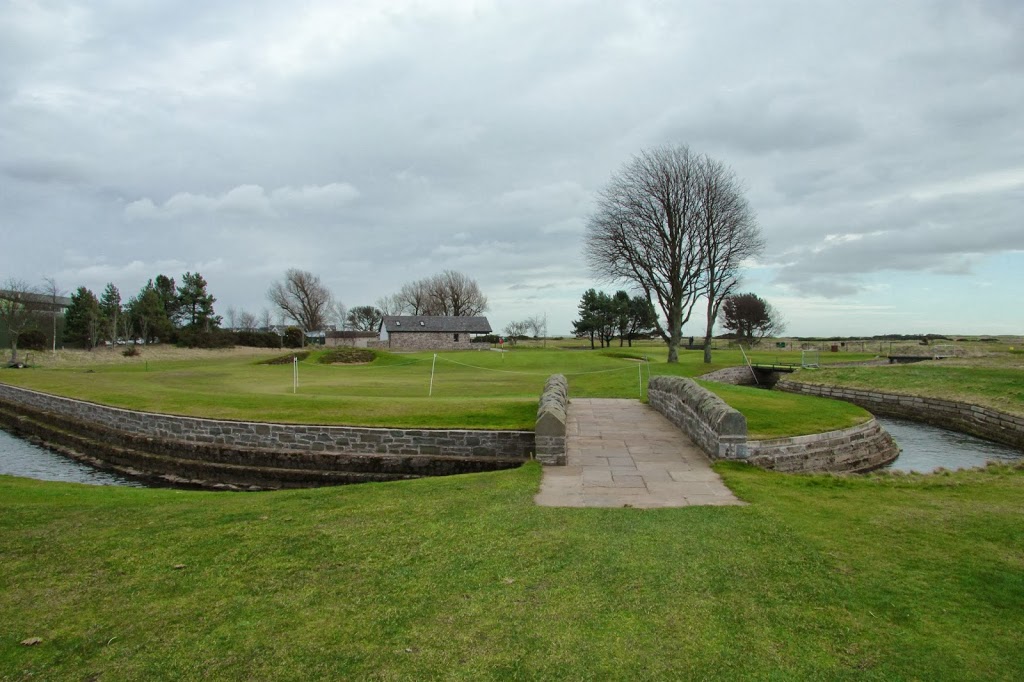 The Barry Burn makes its first major intrusion of the round on the 10th hole. The famous burn guards an area fifty yards short of the green, and, depending on the wind, it can really come into play. The area to the right of the 10th green is also one of the rare examples of greens affecting play on a Scottish links course.
The Barry Burn makes its first major intrusion of the round on the 10th hole. The famous burn guards an area fifty yards short of the green, and, depending on the wind, it can really come into play. The area to the right of the 10th green is also one of the rare examples of greens affecting play on a Scottish links course.
Hole #12 – 407 yards – “Southward Ho”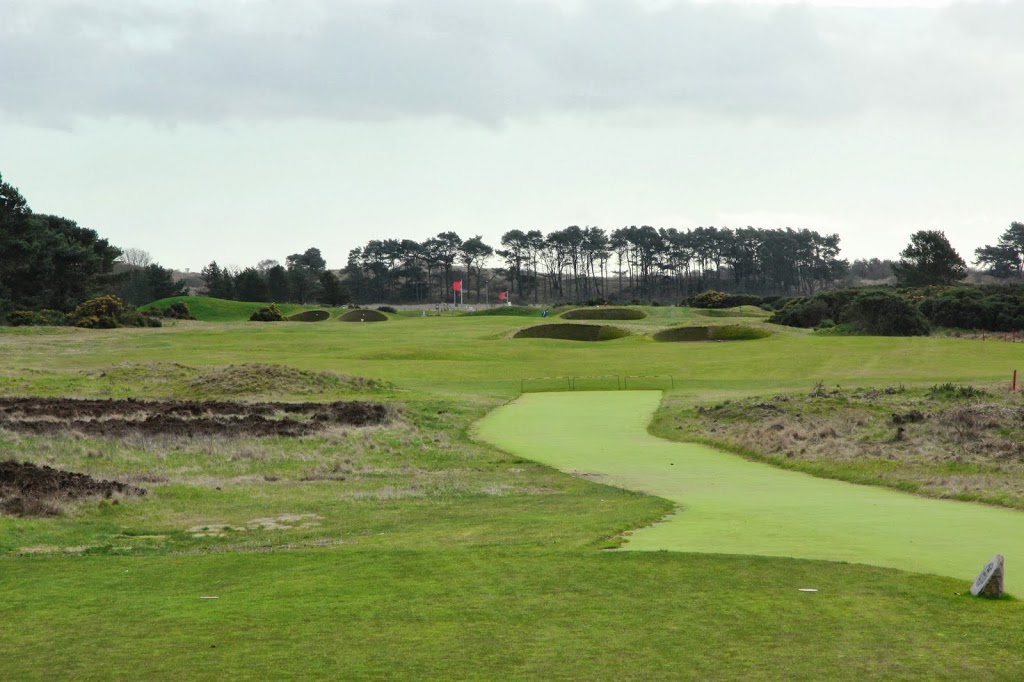 The 12th hole is not the most interesting on the course, but it is an excellent example of the bunkering found at Carnoustie. The photo above shows the view from the tee box, where it is easy to be “psyched out” by the massive traps guarding the hole. The green is larger than it appears from the fairway, and a back left pin puts a premium on positioning in the fairway. The 12th only gets more difficult when imagining thick summer rough on the left side of the hole.
The 12th hole is not the most interesting on the course, but it is an excellent example of the bunkering found at Carnoustie. The photo above shows the view from the tee box, where it is easy to be “psyched out” by the massive traps guarding the hole. The green is larger than it appears from the fairway, and a back left pin puts a premium on positioning in the fairway. The 12th only gets more difficult when imagining thick summer rough on the left side of the hole.
Hole #13 – 141 yards – “Whins” The second par 3 in the round comes at the 13th, and the green complex is very interesting. The green is guarded on three sides by deep bunkers, and the green slopes from right to left. The pin in the photo above is in the back left location, which brings the left hand bunker into play. The 13th is a great test of a golfer’s short irons.
The second par 3 in the round comes at the 13th, and the green complex is very interesting. The green is guarded on three sides by deep bunkers, and the green slopes from right to left. The pin in the photo above is in the back left location, which brings the left hand bunker into play. The 13th is a great test of a golfer’s short irons.
Hole #14 – 459 yards – “Spectacles”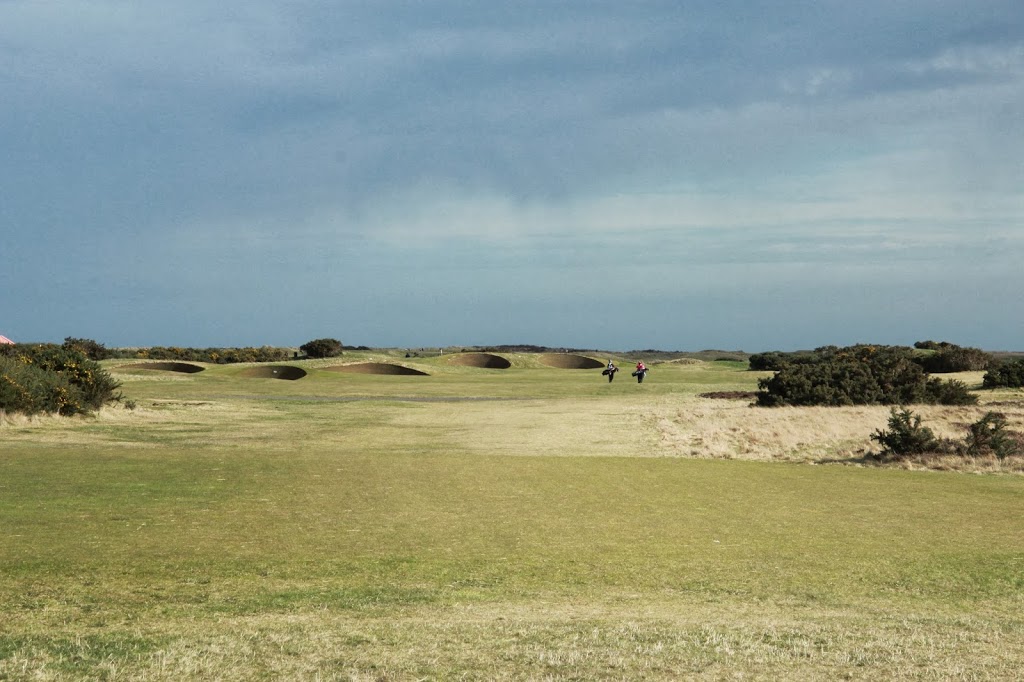 Bunkers abound in this intimidating tee shot on the famous 14th hole at Carnoustie. The left three bunkers challenge the tee shot, while the two spectacle bunkers in the distance (and pictured below) come into play during the approach. After avoiding bunkers off the tee, golfers must choose whether to challenge the massive spectacles on their second strikes.
Bunkers abound in this intimidating tee shot on the famous 14th hole at Carnoustie. The left three bunkers challenge the tee shot, while the two spectacle bunkers in the distance (and pictured below) come into play during the approach. After avoiding bunkers off the tee, golfers must choose whether to challenge the massive spectacles on their second strikes. The famous spectacle bunkers guarding the approach on the 14th can be seen above. They are truly massive.
The famous spectacle bunkers guarding the approach on the 14th can be seen above. They are truly massive.
Hole # 16 – 235 yards – “Barry Burn”
At this point in the round, the group in front of me walked in because of heavy winds, and I joined a remaining brave local who was willing to stick out the gales. In the process, I missed my chance to take a photo. The 16th is a very long par 3 with a large raised green that slopes off on all sides. This is another hole at Carnoustie that is not flashy in any way, but it requires an excellent tee ball to hit the green in regulation.
Hole #17 – 421 yards – “Island” After playing Carnoustie twice, I am still none the wiser about how to tackle the 17th hole. The photo above shows the snaking Barry Burn meandering through the hole. The landing area is between 150 and 240 yards, unless golfers want to take on the 260+ carry over the burn. Golfers standing on the tee who have never seen the hole before would have no idea where to hit the ball. I have added an aerial diagram below in an attempt to do the oddness of the 17th justice. Once the burn is avoided off the tee, a long approach over green side bunkers is still required.
After playing Carnoustie twice, I am still none the wiser about how to tackle the 17th hole. The photo above shows the snaking Barry Burn meandering through the hole. The landing area is between 150 and 240 yards, unless golfers want to take on the 260+ carry over the burn. Golfers standing on the tee who have never seen the hole before would have no idea where to hit the ball. I have added an aerial diagram below in an attempt to do the oddness of the 17th justice. Once the burn is avoided off the tee, a long approach over green side bunkers is still required.
Hole #18 – 421 yards – “Home” The final hole at Carnoustie is the famous site of Van de Velde’s meltdown in the Open Championship. If the hole is playing downwind, a long iron or fairway wood will leave golfers short of the Barry Burn, which once again meanders dangerously through the hole.
The final hole at Carnoustie is the famous site of Van de Velde’s meltdown in the Open Championship. If the hole is playing downwind, a long iron or fairway wood will leave golfers short of the Barry Burn, which once again meanders dangerously through the hole. 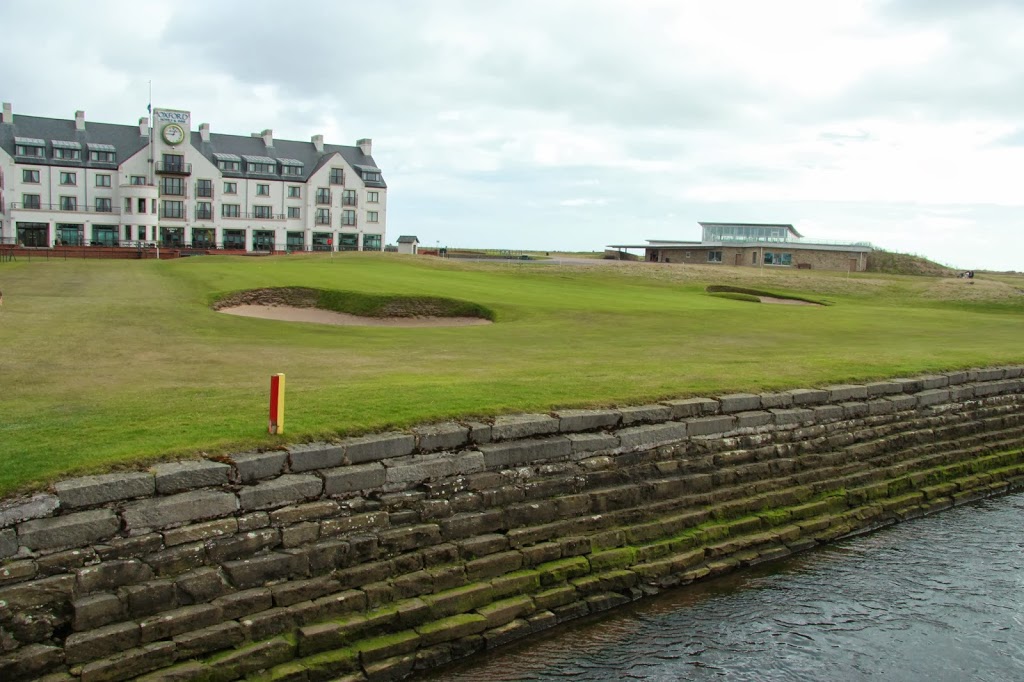 The long green is guarded by bunkers on both sides, and the approach shot can be very long depending on wind direction. It is a fitting end to a very challenging round of golf. Leaving the course having shot a respectable score is a real achievement at Carnoustie. There are very few “easy” shots on the course and any lapse in concentration can result in a meltdown (see Van de Velde in 1999 and Harrington’s final double bogey in 2007).
The long green is guarded by bunkers on both sides, and the approach shot can be very long depending on wind direction. It is a fitting end to a very challenging round of golf. Leaving the course having shot a respectable score is a real achievement at Carnoustie. There are very few “easy” shots on the course and any lapse in concentration can result in a meltdown (see Van de Velde in 1999 and Harrington’s final double bogey in 2007). The enjoyment of playing Carnoustie does not lie in breathtaking views, awesome facilities, or the flashiest design. The great experience comes from playing a very strong course design, having every facet of your game tested at the highest level, and playing on a stage that has hosted some of golf’s most memorable championship moments.
The enjoyment of playing Carnoustie does not lie in breathtaking views, awesome facilities, or the flashiest design. The great experience comes from playing a very strong course design, having every facet of your game tested at the highest level, and playing on a stage that has hosted some of golf’s most memorable championship moments.


11 Comments on “Carnoustie Golf Links Review”
Loved the read, a great honest report and clearly from someone who understands the difference between a great golf course and a course that has nice views in the distance
That is a great compliment – thank you very much!
Great review, and a great read. Would love to get the opportunity to play a such an incredible and challenging course. Hope all is well GreyLand.
-Hethro
Hethro, I’m sure you will come over here to play soon. I hope you are still hitting them straight in the US in the mean time!
You missed the 19th Hole. Excellent post by the way. Shared with ourcarnoustie’s 4,495 facebook followers.
Thank you for the comment and share. I unfortunately had to rush back to St Andrews after the round, but will hopefully be back in April to enjoy the 19th hole!
I enjoyed the read and I enjoyed the course in winds that shut down the ferries and had the pins bent over. My score was horrendous but the fond memories were refreshed thanks to your great write up. I appreciated you not putting the 9th hole in your write up. That hole was well worth forgetting the way I played it.
Rich in California
Hi Rich, I can commiserate about playing the course on a very windy day. I am glad that you liked the post and am happy it brought back good memories. I’d agree with you – the 9th hasn’t treated me too well either…
Pingback: Alfred Dunhill Chamoionship 2014 Round 1 – Carnoustie - Scottish Golf Podcast
Eight of us are doing a Scotland golf trip in July, and Carnoustie is (of course) one of the highlights that we’ll be experiencing. Your review is required reading! Great job.
Hi Graylyn and others, wish I had a wonderful account of my round at Carnoustie to add to the collection… unfortunately I’m here with a “buyer beware” story. Prepaid for my Scotland trip like most of us yanks end up doing. Once in Scotland, I hurt my back on the 2nd day of the 7 day trip! The injury was bad enough that I could not continue playing. Our trip coordinator reached out to the courses to see if any refunds could be obtained… long story short, all the other courses provided either a refund or a voucher to play next time I make it to Scotland. Carnoustie opted to do nothing. No refund, no voucher, nothing. I even reached out directly to appeal my case… nothing. They did acknowledge my request but basically gave me a “no soup for you”! So buyer beware! If you pay in advance, find something to secure a refund should you not actually be able to make it.